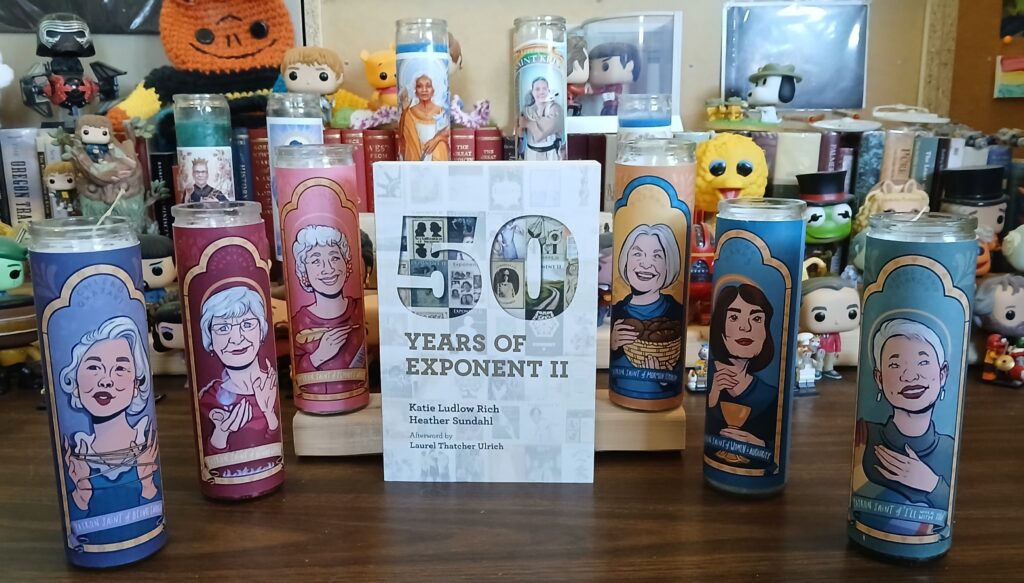Title: 50 Years of Exponent II
Authors: Katie Ludlow Rich and Heather Sundahl
Publisher: Signature Books
Genre: Religious Nonfiction
Year Published: 2024
Number of Pages: 405
Format: Paperback
ISBN: 978-1-56085-477-7
Price: $29.95
Reviewed by Conor Hilton for the Association of Mormon Letters
Katie Ludlow Rich and Heather Sundahl’s 50 Years of Exponent II is a compelling, highly readable history of the Mormon feminist publication Exponent II. Sundahl and Rich easily demonstrate the value and worth of their subject, with this volume leaving me eager to see how other scholars will build on, extend, and complicate the great work that Rich and Sundahl do here.
50 Years of Exponent II has two parts. The first is a history of the publication, presented in eleven chapters that largely follow the eras of the publication’s different editors. The second is an anthology of works from the publication, presented in six chapters—one for each of the five decades of the publication plus one for material from the blog. Both of these parts are extraordinarily valuable. The second part is in many ways a worthy companion to the landmark Mormon Feminism: Essential Writings (edited by Joanna Brooks, Rachel Hunt Steenblik, and Hannah Wheelwright), demonstrating again the diversity of thought among Mormon feminists and the depth and rigor of that thought, rooted in personal experiences. I hope many readers can find companionship and connection in these selections, feeling a newfound link to the rich, polyvocal Mormon feminist tradition.
Rich and Sundahl write the first part in a deeply informed, conversational, and intimate tone that appropriately matches the nature and values of Exponent II and the relationships between the authors and many of the people they write about. The book admirably writes forthrightly about the tensions and difficulties faced by the publication and its staff, detailing the joys, successes, and celebrations. The countless hours of interviews and archival research that Rich and Sundahl did are evident in the way that these people and these stories feel real—in many ways, what could be a small-stakes, mundane set of events is imbued with passion and attention that demonstrates the value, worth, and humanity of these people and their stories. Because of this, the book is a page-turner; I often couldn’t wait to read what happened next to our band of tenacious, determined, “project-oriented women” (xx).
One of the particular pleasures for me in reading 50 Years of Exponent II was delving into some history and people who have been somewhat adjacent to me for most of my life. In the early 90s my family lived in Arlington, MA, and became friends with some of the people who fill the book’s pages, many of whom I heard my parents talk about and mention for years even after we left Boston (notably, Mimmu Hartiala-Sloan, who led an enrichment activity to produce ‘Advent’ binders that we used every Advent season my entire childhood) and at least one woman who remains a family friend (hi, EP!). Then, as the book moves through time closer to the present, the proximity shifts as it becomes women that I know from other places in the Mormon studies world—demonstrating the power and reach of Exponent II and the smallness of the wonderful, peculiar, Mormon world.
I am excited for future scholars to draw on Rich and Sundahl’s work to even more deeply think about the place of Exponent II within the world of women’s publications of the era(s) in question—digging into the religious, political, religio-political, and other publications that can serve as conversation partners for exploring the landscape of American feminism. I am thrilled at the ways that the second part of the book reflects the richness and diversity of women’s thoughts, experiences, and voices within Mormonism, and cannot wait for other scholars to draw on that as they continue to evolve our understanding of what ‘Mormonism’ is and can be, shifting from an institutional-church-focused model to a richer, more complex lived religion model that draws on the actual beliefs and experiences of Mormon women in and out of the pews.
50 Years of Exponent II demonstrates the power of Mormon women’s voices and experiences. The story of Exponent II, as told by Rich and Sundahl, is a story with female friendship, solidarity, and persistence as the core themes. A story of ‘well, I have to do something’ energy. A story that left me in awe of and inspired by the reach of these extraordinary, everyday women. May 50 Years of Exponent II inspire us to pay more attention to the voices of women and people of marginalized genders and help us hear perspectives that we may otherwise be prone to miss.

